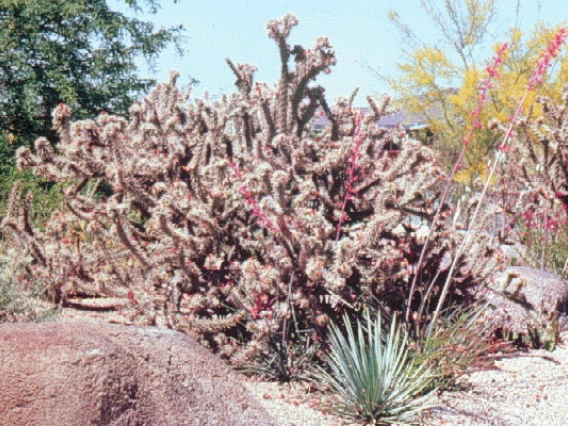

Botanical Name: Cylindropuntia versicolor
Common Name:
English: Staghorn cholla
Spanish: Cholla
O'odham: Ciolim
Family: Cactaceae
Rain Garden Zone: C. versicolor thrives in the terrace Rain Garden Zone, but it may also grow well in the top zone. (2)
Reproduced with permission from "Rainwater Harvesting for Drylands and Beyond" by Brad Lancaster, HarvestingRainwater.com
Flowering Season: March--August (1)
Harvest Season: March--August (1)
Harvest Techniques: Staghorn chollas have less spines than other species of cholla, making them a favored species for harvest. Even so, brush spines off of the cholla bud while it is still on the plant with a stiff brush. Then, use long tongs to remove the clean bud. (1)
Planting Season: Monsoon
Landscape Cultivation: C. versicolor is easiest grown from cuttings when planted with summer rains. Plant staghorn cholla in areas that receive full sun with adequate soil drainage. It is unnecessary to supplement water if the annual rainfall is 5 inches or more (6).
Characteristics: C. versicolor is a shurb or tree-like cactus with acutely branching segments, growing up to 10ft (5). There are 6-8 pinkish-red spines per areole, increasing wiht age. Dark yellow glochids are present in small adaxial tufts. (4) Flowers are 1.5 inch, appearing at the joint tip and vary in color; they may be yellow-green, yellow, orange, red, or pink. Young fruit is barrel-shaped, fleshy, purplish, turning yellow-brown with age. (5)
Ecology: Staghorn cholla is an important desert plant for birds and pollinators (2)
Ethnobotany:
Food:
Cholla buds taste similar to artichoke and are a great source of calcium, magnesium, and polysaccharides. These polysaccharides work to regulare and stabilize blood sugar which increases hydration. Cholla buds must be boiled for 10-20 minutes before freezing or frying for use. Once prepared, cholla buds can be pickled, sautéed, or roasted; added to soups, stews, salsas, and pizzas. (2,3)
Domestic Animals:
Cholla buds may be used in cattle feed (2).
Other:
As mentioned above, cholla buds are a crucial source of polysaccharides, which works to stabilize blood sugar and increase hydration. For this reason, staghorn cholla are often used medicinally. (3)
References:
- Desert Harvesters. (2018). Eat mesquite and more: a cookbook for Sonoran desert foods and living. Tucson, AZ. RainSource Press.
- Lancaster, B. (2006) Rainwater harvesting for drylands and beyond. Tucson, AZ. RainSource Press.
- Hodgson, W.C. (2001). Food Plants of the Sonoran Desert. Tucson: University of Arizona Press. Print.
- SEINet
- Virginia Tech Dendrology
For more information on this plant, see the Campus Arboretum's Desert Landscaping site.
Go to the next tour stop: Mormon tea page or Return to the main Dunbar Spring tour page

